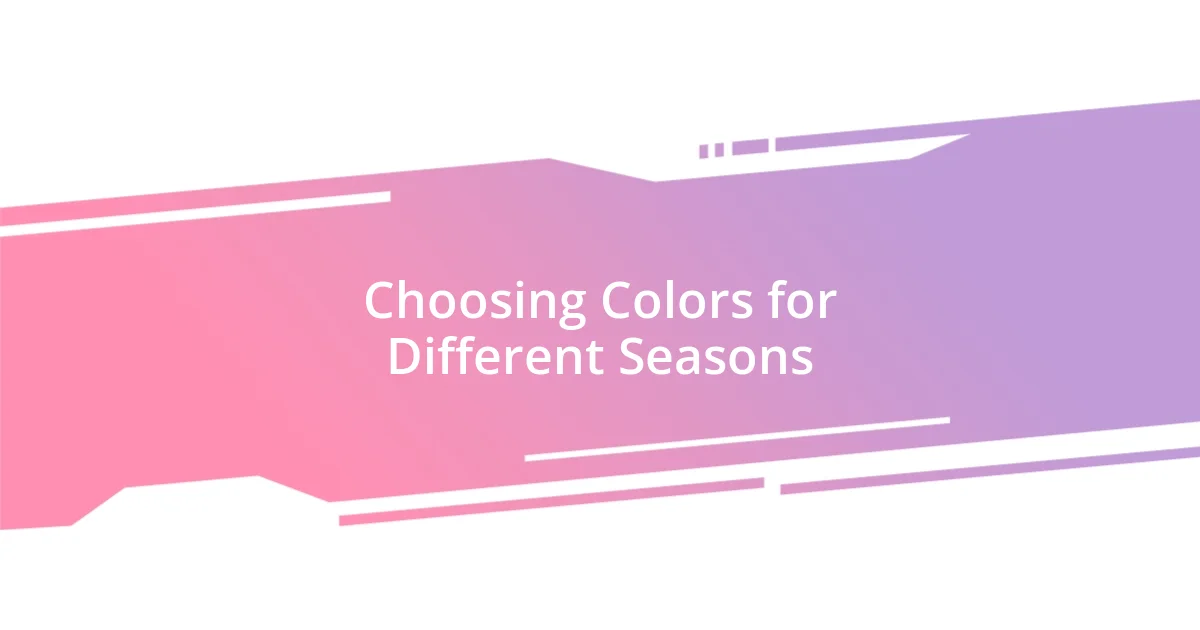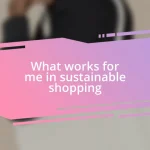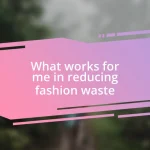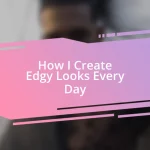Key takeaways:
- Color theory is essential in fashion, influencing emotions and perceptions through the interaction of warm, cool, primary, and secondary colors.
- Personal style reflects individuality and is shaped by personal experiences and emotional connections to clothing, encouraging experimentation with different elements.
- Accessorizing with color accents effectively enhances outfits, creating opportunities for self-expression and connection with others, while thoughtful color choices impact mood and social interactions.

Understanding Color Theory Basics
Color theory is like the secret language of fashion. It helps us understand how colors interact, providing a foundation to create visually appealing outfits. I remember the first time I experimented with complementary colors—wearing a fiery orange against deep blue. It felt exhilarating, like a burst of confidence radiating from my outfit.
One of the basics of color theory is knowing about primary, secondary, and tertiary colors. Primary colors—red, blue, and yellow—are the building blocks, while secondary colors emerge when you mix them. I often find myself pondering: how can simple hues evoke such strong emotions? A soft pastel can bring a sense of calm, while a bold red exudes power. It’s fascinating how something as simple as color can influence our mood and perceptions.
Understanding warm and cool colors is essential for street style. I’ve found that wearing warm tones during the summer instantly boosts my energy, while rich, cool colors in winter help create a cozy vibe. Have you noticed how certain colors can set the tone for your entire day? It’s all interconnected—that’s the beauty of color theory.

Identifying Your Personal Style
Identifying your personal style is an exciting journey. Reflecting on my own experiences, I’ve realized that personal style isn’t just about fashion; it’s a representation of who I am. I remember the time I wore oversized, vintage band tees that spoke volumes about my love for music and nostalgia. Each time I stepped out, it felt like I was telling a story through my outfit, which ultimately gave me a sense of belonging and confidence in my choices.
As I explored different styles, I began to notice trends that resonated with me. For instance, I gravitated towards earthy tones and textures that reflect my appreciation for nature. Interestingly, I could see how these choices aligned with my lifestyle and values. When I choose what to wear, I often ask myself: does this outfit express my current mood or aspirations? This self-reflection has helped me understand the emotional connection between clothing and identity.
The nuances of personal style are revealed when we experiment. I vividly recall the time I mixed tailored trousers with a graphic hoodie. It shocked my friends but felt authentic to me. This blend illustrated my preference for structured yet relaxed looks. Developing your personal style is similar—don’t shy away from mixing different elements; it’s all about what feels right to you.
| Style Element | Emotional Impact |
|---|---|
| Colors | Colors can evoke emotions; warm colors often energize while cool colors soothe. |
| Textures | Textures can convey comfort or sophistication, influencing how I feel in an outfit. |
| Fit | The fit can change my confidence; tailored pieces often make me feel more put-together. |

Analyzing Current Color Trends
Analyzing current color trends means understanding what’s popular in fashion right now and how it resonates with the larger cultural landscape. Recently, I’ve noticed a shift towards bold colors, which seems to mirror a collective desire for self-expression and vibrancy in everyday life. I remember one weekend wandering through a local street fair, where vivid yellows, deep greens, and playful pinks caught my eye on every corner, inspiring me to embrace these lively palettes in my own wardrobe.
Here are some key trends I’ve observed:
– Vibrant Tones: Bright colors like electric blue and neon pink are making a comeback, reflecting energy and enthusiasm.
– Earthy Hues: Offsetting the bright spectrum, warm browns and muted greens grounded in nature evoke calmness and stability.
– Monochrome Looks: Outfits in varying shades of a single color create a striking visual impact while allowing intricate layering.
– Pastels: Soft pastels are emerging, offering a fresh, calming effect that’s perfect for spring and summer.
– Metallic Accents: Shiny metallics add a futuristic touch, often seen in accessories that elevate even the simplest outfit.
These trends often speak to how we feel and how we wish to be seen. I particularly love the way vibrant colors reflect a post-pandemic world—there’s a sense of optimism and a desire to stand out. During a recent outing in a bold yellow dress, I felt like I was radiating happiness, and it sparked conversations with strangers who seemed drawn to that brightness. It’s incredible how color not only influences our personal expression but can also create connections with others.

Choosing Colors for Different Seasons
Choosing colors for different seasons can truly transform the mood of my outfits. I still remember the first time I swapped out my summer pastels for deeper fall hues. Walking through the leafy streets in a rich burgundy sweater felt so cozy and inviting—it’s amazing how the right color can match the season and evoke those familiar autumn vibes. I often wonder, how does a simple change in color shift my overall energy? It’s become clear to me that embracing seasonal palettes not only reflects the environment but also shapes my emotional state.
When winter comes, I gravitate towards darker colors, like navy or charcoal, which somehow resonate with the quiet stillness of the season. I recall one chilly December day when I layered a charcoal coat over a chunky knit in a soft grey. It felt effortless, yet the warmth wrapped around me was comforting. The combination of those colors made me feel snug while still looking chic. I ask myself: how can I use these muted tones to express the beauty of winter while staying comfortable? It’s about finding balance and allowing the colors to reflect the subtle elegance of colder days.
As spring brightens the world, I find myself yearning for vibrant shades again. Those early blooms inspire creativity in my wardrobe. I vividly recall wearing a sunny yellow blouse on a spring stroll; the color brought a smile to my face and sparked compliments from passersby. It’s no surprise that colors like yellow and lilac evoke feelings of joy and renewal. Do you also feel this shift when the seasons change? I genuinely believe that choosing colors in sync with the seasons not only enhances our outfits but also uplifts our spirits.

Mixing and Matching Color Palettes
Mixing and matching color palettes is an art that I find both exciting and challenging. I often experiment with complementary colors—like pairing a deep forest green jacket with a mustard yellow top—and have discovered how this combination can make an outfit pop. There’s something exhilarating about seeing the way two contrasting colors enhance one another, creating a dynamic and visually engaging look that draws attention.
I remember a day spent sifting through my closet, trying to put together an outfit for a brunch date. I decided to layer a soft lavender cardigan over a crisp white shirt, finishing with a pair of vibrant coral pants. As I stood in front of the mirror, I felt a surge of confidence. The harmony of pastels with a bold hue made me feel fresh and stylish. Have you ever considered how mixing different shades can reflect aspects of your personality? I believe it’s a way to visually tell the world who we are.
Another technique I enjoy is utilizing a monochromatic scheme, varying shades of the same color to create depth. For example, a light blue blouse paired with dark denim can offer a seamless and chic look. One evening, I slipped on a range of blues—light, mid, and deep shades—when I attended a gallery opening. I felt like a piece of art myself, a canvas an artist had lovingly layered. It made me wonder: how often do we think of our outfits as art? The ability to mix and match colors speaks volumes about our creativity and mood, and I love how it allows us to express the many facets of our identity.

Accessorizing with Color Accents
Adding color accents through accessories is a game-changer for any outfit. I remember attending a summer rooftop party wearing a simple white dress, and it felt a little too plain for my taste. Then I slipped on a vibrant turquoise statement necklace, and just like that, the entire look came alive. How remarkable is it that a small pop of color can shift an outfit from ordinary to extraordinary? It’s all about balance; sometimes, it only takes a single bold accessory to elevate a look.
Another time, I was preparing for a casual outing with friends and decided to play with contrasting shades. I chose a soft blush scarf to brighten my black leather jacket. As I wrapped it around my neck, it felt like a warm hug that contrasted yet complemented my darker outfit perfectly. Have you ever experienced that moment when the right accessory just clicks? For me, that blush scarf not only added color but also a sense of warmth that drew in compliments. It’s incredible how these accents can embody our mood while showcasing our personality.
I’ve also found great joy in using handbags to introduce color into my wardrobe. Recently, I carried a bright orange crossbody bag while wearing a neutral-toned ensemble. I couldn’t help but notice how that burst of color sparked conversations and smiles from strangers. It made me think: what stories come to life when we incorporate vibrant colors into our style? For me, those accessories are not just functional; they are expressive pieces that add another layer to who I am and how I feel.

Bringing It All Together
Bringing all the elements of color together is where the magic happens for me. I vividly recall a day spent in the city, mixing various shades to curate an outfit just right for the occasion. I slipped into a patterned midi skirt with hues of teal and orange, then layered a soft gray oversized sweater on top. The combination felt effortlessly chic, and walking down the street, I noticed how the colors harmonized with the vibrant surroundings, catching the gaze of passersby. Isn’t it fascinating how the right color combinations can not only enhance our appearance but also create a deeper connection with the world around us?
When I think of effective color coordination, one particular memory stands out. I was attending a friend’s art show, where the atmosphere buzzed with creativity. I decided to wear a bold red blazer over a simple black dress. The red not only made a statement but also conveyed my excitement for the art being showcased. I felt immersed in the vibe of the evening, resonating with both the artwork and the colors I wore. Have you ever noticed how certain colors can uplift your spirits or even transform your mindset? I believe that thoughtful color choices can reflect our emotions, mood, and even intentions.
Finally, I can’t forget the way color can act as a conversation starter in a social setting. Just last week, I paired a cheerful yellow skirt with a floral blouse for a brunch with friends. The moment I entered the café, compliments poured in, not just about the outfit but about the positive energy I seemed to radiate. It’s as if the colors were telling a story, communicating joy and optimism without a word. In moments like these, I find myself realizing that choosing colors consciously contributes to my overall experience, creating connections that linger long after the outfit is forgotten. Don’t you think colors have the power to shape the way we interact with others?














